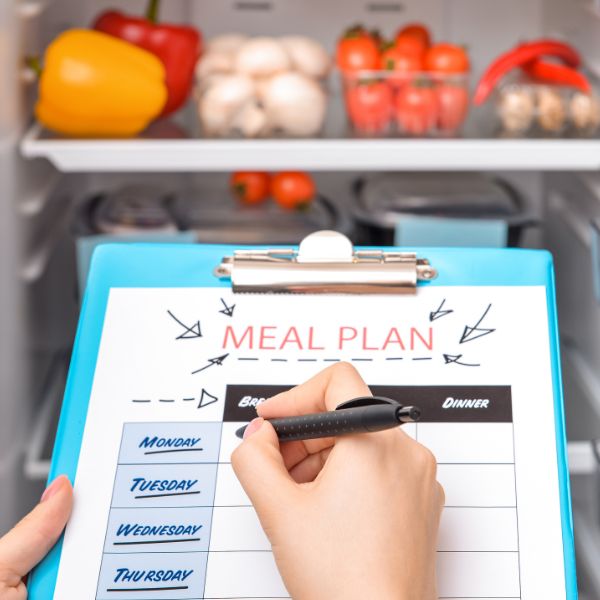Managing a grocery budget effectively while ensuring a nutritious and varied diet can be a challenging task for many households. In the United States, the average household spends about 10% of their total income on food, with nearly 5% spent on groceries for home preparation. As food prices continue to fluctuate and the cost of living rises, finding ways to stretch your grocery dollar while maintaining a healthy lifestyle is more crucial than ever. Here are grocery budgeting and meal planning tips that can help you maximize your food budget.
1. Understanding Your Spending
The first step to managing your grocery budget effectively begins with a detailed understanding of where your money is currently going. For a few weeks, commit to tracking every dollar spent on groceries. This involves keeping all receipts and taking notes on each purchase. You might also consider using budgeting apps that categorize spending automatically, which can simplify the tracking process.
When you review your spending, pay attention to patterns that emerge. Are you making frequent small trips to the store and buying items you don't really need? Are you spending a substantial amount on high-cost items like gourmet cheeses or specialty meats? Identifying these patterns will highlight areas where you might be overspending, such as impulsive purchases of snacks or luxury items that could be scaled back. This initial analysis is crucial as it sets the stage for more informed budgeting and shopping decisions.
2. Setting a Realistic Budget
Once you have a clear picture of your current spending habits, the next step is setting a realistic budget. This should be influenced by your overall financial goals, your typical food consumption, and the size and needs of your household. According to the U.S. Bureau of Labor Statistics, the average annual expenditure on food at home was about $4,942 per household in 2020. Use this figure as a benchmark, but adjust according to your specific circumstances—consider factors like dietary needs, local cost of living, and personal financial goals.
To set your budget, determine a weekly or monthly amount that fits within your total financial plan. It's important to ensure this budget is both sufficient to meet your nutritional needs and realistic enough to stick to. Some people might find that setting a slightly stricter budget helps to cut unnecessary spending, but it should not compromise the quality or nutritional value of the meals.
3. Planning Your Meals
Meal planning is a powerful tool in reducing grocery costs and minimizing waste. By planning your meals for the week ahead of time, you can make a precise shopping list that includes only the items you need. This approach has multiple benefits:
- Cost Reduction: When you buy just what your meals require, you avoid extra purchases that increase your spending and might go to waste.
- Time Efficiency: Knowing exactly what you need to buy reduces the time you spend in the store.
- Waste Minimization: By purchasing only what you intend to use, you reduce the amount of food that might expire unused.
- Healthier Eating: Meal planning encourages home-cooked meals, which are typically healthier and lower in calories than eating out or buying pre-packaged foods.
Start by looking at what you already have in your pantry and refrigerator. Plan meals around these ingredients to further reduce costs. Incorporate a mix of protein sources, vegetables, and starches to keep meals balanced and interesting. Planning also helps you resist the temptation to order takeout on a whim, saving money and potentially leading to healthier eating habits.

4. Shop Smart
- Compare prices: Use apps or flyers to compare prices at different stores in your area.
- Buy in bulk: For non-perishable items and staples like rice, pasta, and canned goods, bulk buying can offer significant savings.
- Choose store brands: These products are typically cheaper than their brand-name counterparts and are often of similar quality.
- Look for sales and use coupons: Plan some of your meals around what's on sale and stock up on staple items when they are discounted.
Learn more about how you can do healthy grocery shopping.
5. Embrace Flexibility in Your Meal Planning
While having a meal plan is foundational to managing your grocery budget efficiently, incorporating a degree of flexibility can amplify your savings and reduce food waste. This flexibility allows you to take advantage of unexpected sales or special offers on ingredients that weren't in your original plan. For instance, if you find a great deal on chicken or bell peppers, consider adjusting your meal plan to include these items. Here are a few tips for flexible meal planning:
- Stay Informed About Sales: Regularly check flyers, apps, or websites for your local grocery stores to know what's on sale before you plan your meals.
- Learn Multiple Recipes for Key Ingredients: Having an arsenal of recipes that use similar ingredients allows you to swap in items you find on sale without disrupting your meal plan drastically.
- Think Creatively: When you find an unexpected sale, think creatively about how you can incorporate the deal into your meal plan. If an ingredient doesn’t fit this week’s plan, consider whether it can be preserved for later use.
Flexibility in meal planning not only saves money but also adds variety to your diet, keeping mealtime interesting and enjoyable.
6. Utilize Everything
A key strategy in maximizing your grocery budget and promoting sustainability is to utilize every part of the food you purchase. This approach minimizes waste and stretches the value of your groceries. Here are practical ways to make the most of your ingredients:
- Use Vegetable Scraps: Save peels, ends, and leaves of vegetables to make a nutritious stock. Store these scraps in the freezer until you have enough to boil into a homemade broth.
- Repurpose Leftovers: Transform leftover meats and vegetables into new dishes. For example, last night's roasted chicken can become today’s chicken soup or chicken salad.
- Plan a "Use-It-Up" Meal: Designate a meal each week to use up any remaining ingredients. This could be a stir-fry, casserole, or soup that can accommodate various leftover items.
8. Cook at Home

While dining out offers convenience and variety, it often comes at a significant financial cost. The Bureau of Labor Statistics highlights that the average American household spends approximately $3,459 annually on meals away from home. Transitioning to home-cooked meals can drastically reduce this expenditure. Here are a few benefits and strategies for cooking at home:
- Cost Efficiency: Cooking at home is generally cheaper than eating at a restaurant because you avoid paying for service, ambiance, and marked-up prices on ingredients.
- Portion Control: Restaurants often serve larger portions, which can lead to overeating or waste. At home, you can control portion sizes, potentially reducing both your calorie intake and food costs.
- Customizable Meals: Cooking at home allows you to cater to personal dietary preferences and restrictions without paying extra.
- Family Involvement: Meal preparation can be a family activity, offering a way to spend quality time together while teaching valuable life skills to children.
To make cooking at home more feasible, consider meal prepping or cooking in batches. This can help save time throughout the week and keeps home-cooked meals as convenient as grabbing takeout.
9. Educate Yourself on Nutrition
Understanding the fundamentals of nutrition is vital for making informed food choices that promote health without straining your budget. Nutritious meals can be economical, contrary to the common misconception that healthy foods are inherently more expensive. Here’s how a good nutritional foundation can help:
- Smart Ingredient Choices: By knowing which nutrients are essential and which foods are rich in these nutrients, you can prioritize buying items that offer the best nutritional bang for your buck. For example, beans and lentils are excellent, low-cost sources of protein and fiber.
- Seasonal Shopping: Educate yourself about which fruits and vegetables are in season. Seasonal produce is not only fresher and more nutritious but also generally cheaper due to the lower cost of transportation and abundance.
- Balanced Diet: Understanding how to balance a meal with appropriate portions of carbohydrates, proteins, and fats ensures comprehensive nutrition, which can improve overall health and prevent costly medical issues in the future.
Resources such as online courses, nutrition blogs, and books can provide valuable information about balanced diets and nutrient-dense foods that fit within a budget. Public health websites and nonprofit organizations often offer free guides and meal planning advice tailored to economical and healthy eating.


